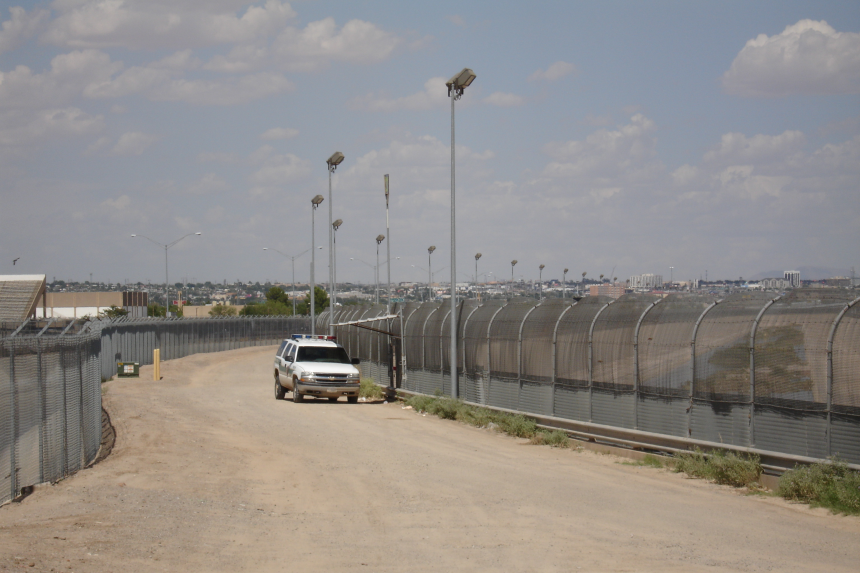This series by American studies professor Ben Railton explores the connections between America’s past and present.
The federal government shutdown dominating the headlines as 2019 begins is entirely connected to one specific, controversial issue: America’s southern border with Mexico. Although the question of funding for President Trump’s proposed wall has been the overt focus of the debate, Trump’s Tweeted threat to “close the Southern border entirely” if a deal is not negotiated makes clear just how fully the border itself has become a pawn in this contentious moment.
There are various complex legal and social issues associated with the border, including whether and how arrivals should be able to apply for asylum, what to do with asylum seekers while they are awaiting those decisions, and what role various federal agencies should play in these processes. But as with so many contemporary debates, unless we can better understand the historical realities that underlie our mythic understanding of the Mexican-American border, those current conversations will necessarily be incomplete.
The most foundational such myth is that the border between the two nations has been a consistent, stable entity. It’s an understandable belief, given that Mexico and the United States have established political and geographic boundaries, and the diplomatic relationships that stem from them, in the 21st century. But the earliest histories of the Mexican-American border reveal not only that it was entirely constructed and malleable, but that the contest over where and how it would be defined shaped both national identities and their relationship to one another.
The 1846-48 Mexican-American War centered directly on that border dispute. The Texas Republic had been independent since its 1836 war with Mexico, and in December 1845 the United States annexed Texas and made it the nation’s 28th state. At the same time, newly elected President James Polk was seeking to purchase land from Mexico and to set the border between the two nations significantly farther south, at the Rio Grande river. When Mexico refused these offers, Polk disregarded Mexican sovereignty and borders, moving U.S. troops into the Mexican region known as the Nueces Strip. Farther west, Polk sent explorer John Frémont and a group of armed men into the Mexican province of Alta California, where Frémont raised an American flag over his fort on Gavilan Peak. Mexico responded predictably to these overt intrusions into its territories, moving its own forces into the disputed regions and skirmishing there with U.S. troops, and the war between the two nations began.

The 1848 Treaty of Guadalupe Hidalgo that cemented the U.S. victory in that war—a treaty negotiated quite literally at gunpoint and without Polk’s knowledge, while U.S. troops were occupying Mexico City—thus did more than cede vast swaths of Southwestern and Western territory to the U.S. It created an entirely new border between the two nations, one in which not only the Nueces Strip and Alta California but much of the rest of the Southwest were suddenly located on the American side. Those areas were still populated by millions of Mexican citizens, however, inhabitants and communities whose ambiguous and fraught new status as Mexican American citizens (a status promised by the treaty, yet highly contested by Anglo settlers) reflected one more layer to the new border’s artificial nature.

So the Mexican-American border came into existence in a contested, controversial, constructed way that produced communal uncertainty for many decades to follow. Ironically, that border also remained entirely open and unpatrolled. Indeed, for half a century after the treaty, the U.S. maintained no presence of any kind on the border, and residents of both nations (and anyone else who found themselves there) could move freely back and forth across it.
The first federal officials to patrol the Mexican-American border did so in the first decade of the 20th century, and in a very targeted and telling way. Numbering around 50-75 at a time, these “mounted guards” (employees of the Department of Commerce and Labor) operated out of El Paso and were tasked solely with watching for Chinese immigrants, the only arrivals defined as illegal in the era. When Congress formalized the guards in the aftermath of the discriminatory Immigration Act of 1917, they likewise emphasized their role in watching for the Asian arrivals (now including many nations within an “Asiatic Barred Zone”). From the outset, these guards existed not to enforce the border and its rules for all arrivals, but to target particular communities defined as undesirable under a bigoted legal system.
It is thus no coincidence that the U.S. Border Patrol was created as an agency within the Department of Labor in 1924, the same year of the Immigration Act of 1924 (also known as the Johnson-Reed Act), which established discriminatory national quotas that affected most arrivals to the United States. These border guards continued to serve in a targeted role, looking for arrivals within those affected national categories (and, at the Canadian border in particular, for illegal alcohol smuggling under Prohibition). Moreover, since nations in the Western Hemisphere were originally exempt from the 1924 law’s quota system, Mexicans (for example) could continue to move freely across the border and into the United States, reflecting just how arbitrary the power of both the border patrol and the border itself were.
Immigration laws and realities have evolved greatly in the century since those 1924 laws; now it is Western Hemisphere arrivals who are most consistently restricted by our immigration categories and preferences, and thus most often targeted by the border patrol. These contemporary laws represent an unfolding legacy of the contested history of the Mexican-American border, a history that belies many of our myths and likewise demands deeper understanding and engagement.
Become a Saturday Evening Post member and enjoy unlimited access. Subscribe now




Comments
Ain’t it curious that Schumer (sniff) and Pelosi (sniff)
are both willing for the Yanqee tax payer to buy an
eight foot thick, twenty foot high, artillery hardened
military grade wall all the way around Israel, but
don’t want so much as a fence on the Yanqee
border between Hollywood, Broadway and some
of the most vicious drug cartels and street gangs
in the world?
Ms. Pelosi (sniff) and Mr. Schumer (sniff) needn’t
worry. Even if Trump builds his wall, I’m sure
Schumer’s (sniff) and Pelosio’s (sniff) friends in
Hollywood and on Broadway will still get enough
product over the border to support their cocaine
habits.
How about all the money from the Bush administration?
Ben, lots of us do understand the difference between asylum seekers and illegal immigrants.
You forgot to mention Obama and Dems put up leglislation offering tens of millions of dollars, perhaps billions and it got shot down by McConnell and GOP. Just so Obama couldn’t get credit for anything.
Also you people talk like there is no wall at all, like its just “open borders ” as uou noted. Truth is theres plenty of walls and fences where needed.
I actually live and hunt near the border. Try going across and get back. Lol
First, do not refer to the wall as “President Trump’s wall. It is the citizens of the USA who demand it. Second, there is no controversy regarding what to do with “asylum seekers” originating south of the border. We have a very effective system by which asylum seekers can become citizens. Authors such as this one are notorious for reaching the gullible through skewed verbiage .. this is an example. Do NOT confuse illegal aliens with asylum seekers. There is a world of difference. Many readers have not been to the border and don’t understand the issue. Indeed, illegal aliens are criminals the monent they enter the country illegally, rather than going to any one of the nine US consulate offices in Mexico to apply for citizenship legally. Yes, the border has gone through historical controversy, like all national borders; however, there is no controversy regarding the unfettered entry by very undesirable people and substances from all corners of the globe. Democrats have aligned themselves with anti-USA elements within the media and outside our nation to dilute the seriousness and danger of allowing an open southern border. Regarding the funding of the border wall, the people are asking for less than one-tenth of one percent of the budget as a one time security investment and it is flatly denied by Democrats. During the Obama administration, 53 billion dollars was granted and allocated to building the wall … what did Obama’s office do with this money ???
PS. Since there’s so much more to say about these histories than I was able to here, a couple of sources for further reading and conversation:
–Maria Amparo Ruiz de Burton’s historical novel *The Squatter and the Don* (1885) details Mexican American life after the Treaty very fully. See for example Chapter 2:
http://www.gutenberg.org/files/35538/35538-h/35538-h.html#chapter-ii-the-don-s-view-of-the-treaty-of-guadalupe-hidalgo
–And Carey McWilliams’ *North from Mexico* remains a really great history of Mexican Americans and the border, including lots about the post-1920s histories I wasn’t able to get to in this piece. Here’s an excerpt:
https://books.google.com/books/about/North_from_Mexico_The_Spanish_Speaking_P.html?id=cVPhCwAAQBAJ&printsec=frontcover&source=kp_read_button#v=onepage&q&f=false
Thanks,
Ben